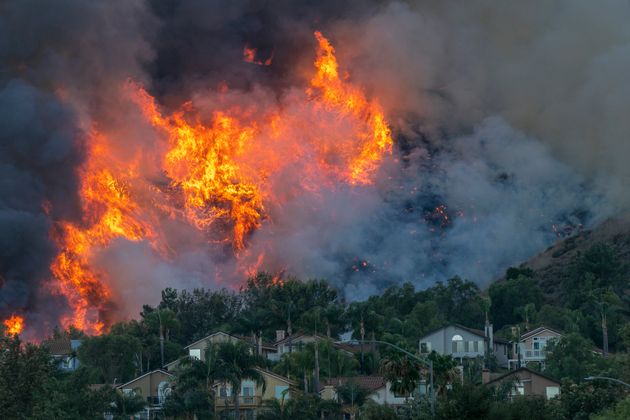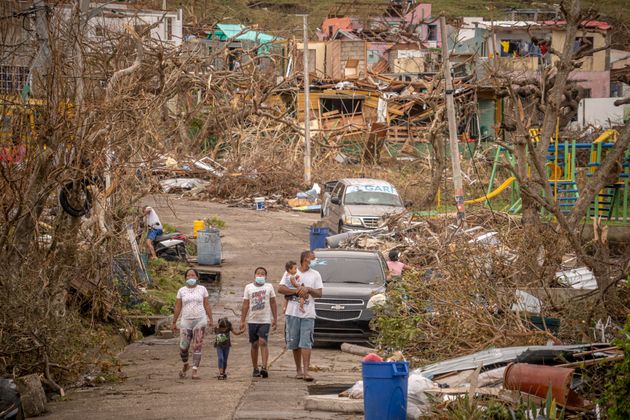From record-breaking bushfires to devastating hurricanes, human-driven climate change keeps killing us.

|
|
A bushfire burns in Bodalla, New South Wales, Australia, Saturday,
January 25, 2020. AP Photo/Noah Berge |
Even as global carbon emissions were expected to decrease by about 7% this year due to coronavirus restrictions on normal activities, this has only “briefly slowed ― but far from eliminated ― the historic and ever-increasing burden of human activity on the Earth’s climate,” United Nations environmental researchers wrote in a December report.
This year has seen record-breaking heat, bushfires and storms. U.N. Secretary-General António Guterres urged every country to declare a “climate emergency.”
Throughout President Donald Trump’s time in office, his administration rolled back environmental protections around clean water, auto emissions and more.
It remains to be seen what President-elect Joe Biden will do to curb the nation’s impact on the global climate, but he and Vice President-elect Kamala Harris have named climate change as a top priority, including a commitment to rejoin the Paris climate accord that Trump pulled the US out of.
Here are some of the ways climate change has wreaked havoc on Earth’s inhabitants this year.

|
|
Flames rise near homes during the Blue Ridge fire on Oct. 27 in
Chino Hills, California. David McNew via Getty Images
|
Australia has faced the cost of a devastating and lengthy bushfire season that burned nearly 12 million hectares of bushland, killing 33 people and an estimated 1 billion native animals.
Dubbed a “black summer” by Prime Minister Scott Morrison, the unusually prolonged and intense bushfires have increased pressure on the government to reduce greenhouse gas emissions.
Scientists have warned that increased temperatures and heatwaves will lead to more dangerous fire seasons and severe weather events, while shorter winters will reduce the window for hazard reduction to mitigate the impact of fires.
This year was also a record-breaker for fires in California — again. As of last year, four of the five largest wildfires in the fire-prone state had happened this decade alone.
This year, four of the five largest wildfires in state history happened this year alone.
Wildfires have been worsening in California, with hotter temperatures and dry conditions often combining with high winds to create a longer, more destructive fire season.
Scientists have linked the worsening fires across the Western U.S. to climate change.
Some regions are being ravaged over and over, year after year, such as Northern California’s wine country, which was hit by deadly fires in 2017 only to be the site of the fifth-biggest fire in state history this year, spurring mass evacuations.
In August, the North Complex fire killed 15 people in Butte County — the same county as 2018’s Camp fire, which killed 85 people and burned down nearly the entire town of Paradise.
“CLIMATE. CHANGE. IS. REAL,” tweeted California Gov. Gavin Newsom in September, as fires across the state burned millions of acres, a record-breaking heat wave engulfed Southern California, and broad swaths of the state were blanketed with unhealthy levels of smoke.

|
|
A man with an umbrella for shade walks past the thermometer at
Calvary Church in Woodland Hills, California, as it registers 116
degrees Fahrenheit on Aug. 19. Al Seib via Getty Images |
This year is on track to be one of the two hottest ever on record. The planet had its hottest September and its second hottest July and November ever, according to the National Oceanic and Atmospheric Administration.
This August — the third hottest August in the nation’s history — Phoenix saw average temperatures of 99 degrees. And in California, a record-breaking heat wave over Labor Day weekend brought Los Angeles County its highest temperature ever, 121 degrees.
Globally, the past five years have been the Earth’s hottest in recorded history, with 2016 the hottest ever, followed by 2019, 2017, 2015 and 2018. It remains to be seen if 2020 will usurp 2016 as the hottest year ever, or come in second place.
These recent peak temperatures follow decades of warming around the globe, largely caused by human-made emissions. Higher temperatures are linked to a range of dangerous natural disasters including extreme floods, hurricanes, wildfires ― and deaths.
Meanwhile Australian summers are now effectively twice as long as its winters as climate change has increased temperatures since the middle of the last century, research released in the wake of the nation’s unprecedented fire season showed in March.
The report by the Australia Institute, a Canberra-based think tank, compared data from the past two decades with mid-20th century benchmarks of temperatures at the calendar start of seasons in temperate and sub-tropical parts of the country.
Over the last two decades, summer across most of Australia has been on average one month longer than half a century ago, while winter has contracted by an average three weeks.
Over the past five years, the analysis showed, Australian summers were on average 50% longer than they were in the mid-twentieth century based on temperature readings.
“Our findings are not a projection of what we may see in the future,” said Richie Merzian, climate and energy program director at the Australia Institute. “It’s happening right now.”

|
|
A family walks amid destruction on Nov. 22 in Providencia,
Colombia, which was hit by Hurricane Iota as a Category 5 storm, the
strongest on record to affect the country. Getty Images via Getty Images |
The 2020 storm season was the most active on record. Subtropical storm Theta in November was the 29th named storm of the Atlantic season— breaking the record for the highest number of storms in a year. For only the second time in history, the predetermined list of 21 storm names ran out, leading scientists to use the Greek alphabet to name subsequent storms.
Several of this year’s hurricanes and tropical storms were deadly, including tropical storm Isaias, which ravaged the East Coast in August, Hurricane Delta, which tore through the mid-Atlantic in October, and Hurricane Zeta, which destroyed homes across the Southeast US later that month and left over a million people without power.
Hurricane Laura, which made landfall in Louisiana in August, killed over a dozen people and carried with it 150-mph winds, tying an 1856 hurricane for the strongest to make landfall in the state.

|
|
Sea ice coverage in September 2020. The purple line indicates the
previous median ice coverage extent from 1981-2010. National Snow and Ice Data Center, University of Colorado,
Boulder |
And Typhoon Vamco, which hit the Philippines in November, killed dozens of people, submerged villages and cut power to millions.
Scientists have found that climate change has likely increased the intensity of hurricanes.
A study published in the journal Nature in November found that in recent decades, hurricanes have increasingly stayed more intense for longer periods, brining higher winds and more flood damage inland as they’ve gathered more moisture from warming oceans.
Dramatic loss of sea ice
This year, the Arctic’s sea ice cover shrank to its second lowest levels since records started being kept in the late 1970s, according to NASA.
The 14 smallest ice coverage extents for the region have all occurred in the last 14 years, per the NOAA.
The amount of Arctic sea ice coverage each October has declined about 10% per decade — losing an area about the size of South Carolina each year, according to the National Snow and Ice Data Center.
Sea ice, or frozen ocean water, is “a critical component of our planet because it influences climate,” according to the center. As rising temperatures melt broad swaths of sea ice over time, there are fewer white surfaces to reflect the sunlight and more heat is absorbed at the Earth’s surface, leading to temperatures rising even further in a vicious cycle.
Links
- 2020 Was Supposed To Be Our Best Last Chance To Save The Planet. So How Did We Do?
- BOM and CSIRO State of the Climate 2020 shows Australia is experiencing climate change now
- (AU) Heat Is The 'Silent Killer' Of Australia's Bushfire Season And Experts Say Climate Change Is The Root Cause
- Climate Change: 2020 Set To Be One Of The Three Warmest Years On Record
- (AU) Australia Endures Hottest Spring Ever, With Temperatures More Than 2C Above Average
- Gizmodo Year In Review
- (AU) 2020 Climate Year in Review - Legal Insights
- Counting the cost 2020: a year of climate breakdown (pdf)
- Climate change: Extreme weather causes huge losses in 2020
- Fires and floods: Brace yourself for more of this, experts say
- Is climate change the crisis we forgot about?
- More than 60,000 koalas among three billion animals impacted by Australia's Black Summer bushfires
- 2021 will be cooler but still in top six warmest

















